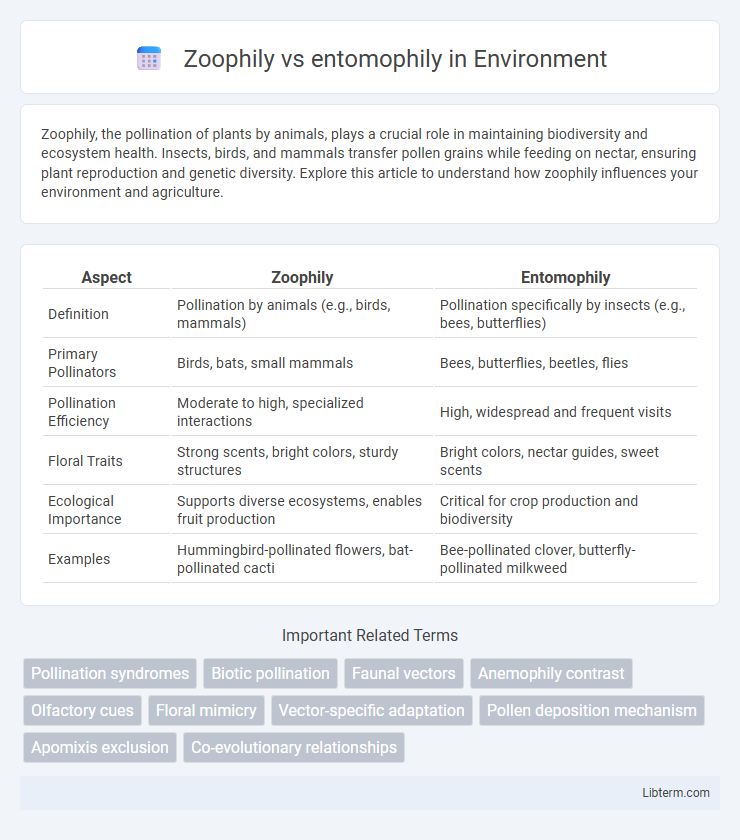Zoophily, the pollination of plants by animals, plays a crucial role in maintaining biodiversity and ecosystem health. Insects, birds, and mammals transfer pollen grains while feeding on nectar, ensuring plant reproduction and genetic diversity. Explore this article to understand how zoophily influences your environment and agriculture.
Table of Comparison
| Aspect | Zoophily | Entomophily |
|---|---|---|
| Definition | Pollination by animals (e.g., birds, mammals) | Pollination specifically by insects (e.g., bees, butterflies) |
| Primary Pollinators | Birds, bats, small mammals | Bees, butterflies, beetles, flies |
| Pollination Efficiency | Moderate to high, specialized interactions | High, widespread and frequent visits |
| Floral Traits | Strong scents, bright colors, sturdy structures | Bright colors, nectar guides, sweet scents |
| Ecological Importance | Supports diverse ecosystems, enables fruit production | Critical for crop production and biodiversity |
| Examples | Hummingbird-pollinated flowers, bat-pollinated cacti | Bee-pollinated clover, butterfly-pollinated milkweed |
Introduction to Plant Pollination Mechanisms
Zoophily and entomophily represent key plant pollination mechanisms where zoophily involves animal pollinators such as birds and bats, while entomophily specifically refers to insect-mediated pollination by bees, butterflies, and beetles. These processes enhance genetic diversity and reproductive success by enabling pollen transfer between flowers, crucial for angiosperm survival. Understanding these specialized pollination strategies reveals their ecological roles and adaptations critical for crop production and biodiversity maintenance.
Understanding Zoophily: Animal-Mediated Pollination
Zoophily refers to pollination facilitated by animals, primarily involving mammals, birds, and insects as pollinators transferring pollen between flowers. This process enhances genetic diversity and plant reproduction in ecosystems where abiotic factors are insufficient for effective pollen dispersal. Unlike entomophily, which specifically involves insect pollinators, zoophily encompasses a broader range of animals, making it a crucial mechanism for the survival of many angiosperms.
Exploring Entomophily: Insect-Driven Pollination
Entomophily, a key pollination mechanism driven by insects such as bees, butterflies, and beetles, plays a crucial role in the reproductive success of flowering plants. This insect-driven pollination enhances genetic diversity and increases crop yields by facilitating effective pollen transfer between flowers. Compared to zoophily, which includes a broader range of animal pollinators, entomophily specifically capitalizes on insect behavior and morphology to optimize pollination efficiency.
Key Differences Between Zoophily and Entomophily
Zoophily refers to pollination by animals, including mammals, birds, and insects, whereas entomophily specifically denotes pollination by insects only, primarily bees, butterflies, and beetles. Zoophilous plants often exhibit traits like strong scent, bright colors, and nectar production to attract diverse pollinators, while entomophilous plants usually have specialized floral structures adapted to insect visitors. The key difference lies in the broader range of animal pollinators in zoophily versus the insect-specific interaction in entomophily, influencing floral adaptations and pollination efficiency.
Common Examples of Zoophilous Plants
Zoophilous plants commonly include orchids, which attract pollinators like bees and butterflies, and fleshy fruits such as apples and berries that rely on animals for seed dispersal. Other notable examples are flowers like hibiscus and passionflower, which depend on birds and bats for pollination. These plants have evolved bright colors, nectar production, and strong scents to entice specific animal vectors, highlighting their coevolution with faunal agents.
Notable Entomophilous Plant Species
Notable entomophilous plant species include orchids (Orchidaceae), sunflowers (Helianthus annuus), and apple trees (Malus domestica), all of which rely heavily on insect pollinators such as bees, butterflies, and beetles for reproduction. These plants have evolved specialized structures, vivid colors, and nectar production to attract specific insect pollinators, enhancing pollination efficiency. Entomophily contrasts with zoophily by focusing on insect-mediated pollination rather than vertebrate pollinators like birds or mammals.
Adaptive Floral Traits for Zoophily
Adaptive floral traits for zoophily include vibrant colors, strong fragrances, and nectar rewards that attract animal pollinators such as birds, bats, and mammals. Flowers often develop structural features like tubular shapes and sturdy petals to accommodate animal visitors and facilitate effective pollen transfer. These adaptations enhance reproductive success by ensuring targeted pollination through animal-mediated interactions.
Flower Adaptations Specific to Entomophily
Flowers adapted to entomophily exhibit bright colors, strong fragrances, and nectar production to specifically attract insect pollinators such as bees, butterflies, and beetles. These floral adaptations often include complex shapes and landing platforms that facilitate insect visitation and pollen transfer. Pollen grains in entomophilous flowers are typically sticky or spiny, enabling attachment to insect bodies for effective cross-pollination.
Ecological Significance of Zoophily and Entomophily
Zoophily and entomophily play crucial roles in ecosystem functioning by facilitating plant reproduction through animal and insect pollinators, respectively. Zoophily, involving vertebrates like birds and bats, enhances genetic diversity and plant survival in diverse habitats, including tropical and arid regions. Entomophily, primarily driven by bees, butterflies, and beetles, supports crop production and maintains biodiversity by enabling cross-pollination in various terrestrial ecosystems.
Comparing the Benefits and Challenges of Each Pollination Method
Zoophily, pollination by animals such as birds and mammals, offers targeted pollen transfer and higher genetic diversity but requires specialized floral traits and risks depending on animal behavior. Entomophily, pollination by insects like bees and butterflies, benefits from widespread pollinator presence and efficiency in various environments but faces challenges from pollinator decline and habitat loss. Both methods are crucial for ecosystem stability, yet balancing their ecological roles demands understanding species-specific interactions and environmental impacts.
Zoophily Infographic

 libterm.com
libterm.com